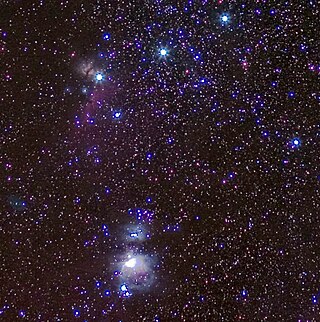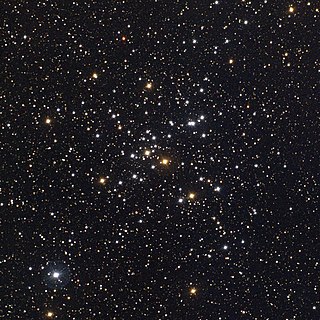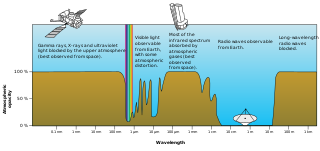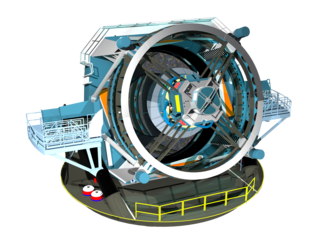
Amateur astronomy is a hobby where participants enjoy observing or imaging celestial objects in the sky using the unaided eye, binoculars, or telescopes. Even though scientific research may not be their primary goal, some amateur astronomers make contributions in doing citizen science, such as by monitoring variable stars, double stars, sunspots, or occultations of stars by the Moon or asteroids, or by discovering transient astronomical events, such as comets, galactic novae or supernovae in other galaxies.

A Dobsonian telescope is an altazimuth-mounted Newtonian telescope design popularized by John Dobson in 1965 and credited with vastly increasing the size of telescopes available to amateur astronomers. Dobson's telescopes featured a simplified mechanical design that was easy to manufacture from readily available components to create a large, portable, low-cost telescope. The design is optimized for observing faint, deep-sky objects such as nebulae and galaxies. This type of observation requires a large objective diameter of relatively short focal length and portability for travel to less light-polluted locations.

Observational astronomy is a division of astronomy that is concerned with recording data about the observable universe, in contrast with theoretical astronomy, which is mainly concerned with calculating the measurable implications of physical models. It is the practice and study of observing celestial objects with the use of telescopes and other astronomical instruments.

A deep-sky object (DSO) is any astronomical object that is not an individual star or Solar System object. The classification is used for the most part by amateur astronomers to denote visually observed faint naked eye and telescopic objects such as star clusters, nebulae and galaxies. This distinction is practical and technical, implying a variety of instruments and techniques appropriate to observation, and does not distinguish the nature of the object itself.

Messier 41 (also known as M41 or NGC 2287) is an open cluster in the constellation Canis Major. It is sometimes referred to as the Little Beehive Cluster. It was discovered by Giovanni Batista Hodierna before 1654 and was perhaps known to Aristotle about 325 BC. It lies about four degrees almost exactly south of Sirius, with which it forms a roughly equilateral triangle with Nu2 Canis Majoris to the west—all three figure in the same field in binoculars.
The Meade Instruments is an American multinational company headquartered in Watsonville, California, that manufactures, imports, and distributes telescopes, binoculars, spotting scopes, microscopes, CCD cameras, and telescope accessories for the consumer market. It is the world's largest manufacturer of telescopes.

An equatorial mount is a mount for instruments that compensates for Earth's rotation by having one rotational axis, called polar axis, parallel to the Earth's axis of rotation. This type of mount is used for astronomical telescopes and cameras. The advantage of an equatorial mount lies in its ability to allow the instrument attached to it to stay fixed on any celestial object with diurnal motion by driving one axis at a constant speed. Such an arrangement is called a sidereal drive or clock drive. Equatorial mounts achieve this by aligning their rotational axis with the Earth, a process known as polar alignment.
Celestron, LLC is a company that manufactures telescopes and distributes telescopes, binoculars, spotting scopes, microscopes, and accessories manufactured by its parent company, the Synta Technology Corporation of Taiwan.

A finderscope is an accessory sighting device used in astronomy and stargazing, typically a small auxiliary refracting telescope/monocular mounted parallelly on a larger astronomical telescope along the same line of sight. The finderscope usually has a much smaller magnification than the main telescope, thus providing a larger field of view, useful for manually pointing the main telescope into a roughly correct direction that can easily place a desired astronomical object in view when zooming in. Some finderscopes have sophisticated reticles to more accurately aim the main telescope and/or even perform stadiametric measurements.

Visible-light astronomy encompasses a wide variety of astronomical observation via telescopes that are sensitive in the range of visible light. Visible-light astronomy is part of optical astronomy, and differs from astronomies based on invisible types of light in the electromagnetic radiation spectrum, such as radio waves, infrared waves, ultraviolet waves, X-ray waves and gamma-ray waves. Visible light ranges from 380 to 750 nanometers in wavelength.

NGC 246 is a planetary nebula in the constellation Cetus. It is the first known planetary nebula to have a hierarchical triple star system at its center. The nebula and the stars associated with it are listed in several catalogs, as summarized by the SIMBAD database. NGC 246 was discovered by William Herschel in 1785.

The Vera C. Rubin Observatory, formerly known as the Large Synoptic Survey Telescope (LSST), is an astronomical observatory currently under construction in Chile. Its main task will be carrying out a synoptic astronomical survey, the Legacy Survey of Space and Time. The word synoptic is derived from the Greek words σύν and ὄψις, and describes observations that give a broad view of a subject at a particular time. The observatory is located on the El Peñón peak of Cerro Pachón, a 2,682-meter-high mountain in Coquimbo Region, in northern Chile, alongside the existing Gemini South and Southern Astrophysical Research Telescopes. The LSST Base Facility is located about 100 kilometres (62 mi) away from the observatory by road, in the town of La Serena. The observatory is named for Vera Rubin, an American astronomer who pioneered discoveries about galaxy rotation rates.
Orion Telescopes & Binoculars is an American retail company that sells telescopes, binoculars and accessories online and in-store for astronomy and birdwatching. It was founded in 1975 and has corporate offices in Watsonville, California. A large proportion of its products are manufactured by the Chinese company Synta for the Orion brand name. Orion Telescopes & Binoculars ships its products to the United States and over 20 other countries. Orion puts out a semi-quarterly mail-order catalog as well as email catalogs. The company is a prominent advertiser in North American astronomy magazines, such as Sky & Telescope and Astronomy.

In amateur astronomy, "GoTo" refers to a type of telescope mount and related software that can automatically point a telescope at astronomical objects that the user selects. Both axes of a GoTo mount are driven by a motor and controlled by a computer. It may be either a microprocessor-based integrated controller or an external personal computer. This differs from the single-axis semi-automated tracking of a traditional clock-drive equatorial mount.
John C. Diebel is the founder of telescope manufacturer Meade Instruments and a recipient of the Franklin Institute's Bower Award For Business Leadership.

The Givatayim Observatory is a public observatory that was founded in 1968 by the Israeli Astronomical Association and the Givatayim municipality.

The Heights Observatory is an Astronomical Observatory at The Heights School in Modbury Heights, Adelaide, South Australia.
The Celestron SkyScout was a model of handheld consumer electronic instrument for astronomical orientation and education, similarly to the competitor product mySky by Meade Instruments. The general class of zero-magnification sky-orientation scopes using modern geodesy was made possible by the commercialisation of GPS and other GNSS systems in the early 21st century, and the SkyScout was an early example of such use despite being hampered by technical and price limitations.












